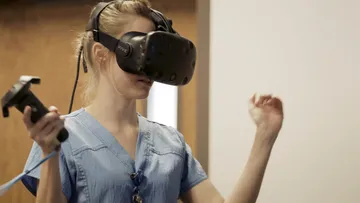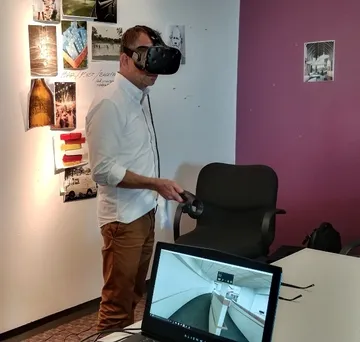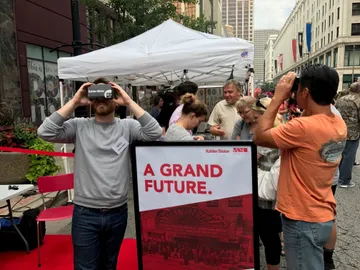Virtual Reality as a Design Tool


Architectural designers need to be as skilled in describing the ideas that go into a building as much as they know how to ultimately assemble one. If the client is unsure about the direction a building is taking, a design discussion can stall around the time someone says something like:
“If I could only see this space from the other side of the room, I’d be able to make my decision”
“Would this room still work if we move these walls?”
“Can I see this space with different finishes?”
Where the answer may once have been: “Let me redraw the plan and show you later,” our answer has changed to “Yes, let me show you now”.
One of the ways that Kahler Slater has recently been facilitating better discussion about (and understanding of) a design is through virtual reality (VR). We believe this is the next evolution in a long line of tools which allow designers to better convey the broad concepts, as well as the intricacies, of a future building.

Virtual reality allows the user to be fully immersed in the design, understanding the designers’ intent more quickly than analyzing lines on paper. Our clients can request changes to the building and see the results in real time, allowing them to make confident decisions at the same meeting in which the questions are asked. This allows them to have a real, measurable and positive impact on the outcome of the design, boosts productivity in meetings where decisions must be made, and builds confidence in the design team to deliver the best possible product. Plus, people tend to have a blast when they see how their colleagues react to seeing their future building for the first time.

There are many reasons to use VR, and there are almost as many ways to integrate it into a workflow. While the current popular image is someone with hardware on head and in hand, there will always be those who are unable to (or would rather not) don the headgear and navigate a virtual world. There are times when setting up all that equipment would be infeasible because of limited space, time, or both. Sometimes all you want to do is share a great design at a cocktail party. By building a virtual tour, we can carry architecture on the smartphones in our pockets and present it in a similar way to the full setup. The scalability of VR is one of its great strengths as it allows designers to show their work with various levels of interactivity and immersion.

With the aesthetic similarity between renderings and VR it’s logical to assume that one will replace the other as the primary vehicle for architectural visualization, but we believe that there are reasons to use both in tandem. Every new visual art builds on the technology which preceded it to find new ways to tell a story. Photography didn’t replace paintings, nor did it end with the advent of cinema. Each medium finds a new, specific niche. A rendering is great at portraying a feeling of a space, an idealized version of a building, a snapshot in time. But how can a single image fully convey the flow of a space, describe how a concept is realized throughout a building, and show how it changes from different points of view or times of day? While there will always be a reason to distill a design down to a single powerful image, experiencing it in VR directly links explanation to understanding.

We believe VR is an immensely versatile tool that not only bridges the gap between polished renderings and technical drawings, but can inject a little (dare I say it) fun into the decision-making process.
Architects get excited about the opportunities in a project; VR allows our clients to also experience the opportunities present in their innovative design.
